Marie Antoinette
| Marie Antoinette | |||||
|---|---|---|---|---|---|
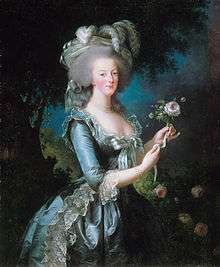 Marie Antoinette with the Rose Portrait by Louise Élisabeth Vigée Le Brun, 1783. | |||||
| Queen consort of France and Navarre | |||||
| Tenure | 10 May 1774 – 4 September 1791 | ||||
| Queen consort of the French | |||||
| Tenure | 4 September 1791 – 10 August 1792 | ||||
| Born |
2 November 1755 Hofburg Palace, Vienna, Austria, Holy Roman Empire | ||||
| Died |
16 October 1793 (aged 37) Place de la Révolution, Paris, France | ||||
| Burial |
21 January 1815 Basilica of St Denis, France | ||||
| Spouse | Louis XVI of France | ||||
| Issue |
Marie Thérèse, Queen of France Louis Joseph, Dauphin of France Louis XVII of France Princess Sophie | ||||
| |||||
| House | House of Habsburg-Lorraine | ||||
| Father | Francis I, Holy Roman Emperor | ||||
| Mother | Maria Theresa | ||||
| Religion | Roman Catholic | ||||
| Signature |
| ||||
Marie Antoinette (/ˈmæriˌæntwəˈnɛt/, /ˌɑ̃ːntwə-/, /ˌɑ̃ːtwə-/, US /məˈriː-/;[1] French: [maʁi ɑ̃twanɛt]; born Maria Antonia Josepha Johanna (2 November 1755 – 16 October 1793), was the last Queen of France prior to the French Revolution. She was born an Archduchess of Austria, and was the fifteenth and second youngest child of Empress Maria Theresa and Francis I, Holy Roman Emperor.
In April 1770, upon her marriage to Louis-Auguste, heir apparent to the French throne, she became Dauphine of France. On 10 May 1774, when her husband ascended the throne as Louis XVI, she became Queen of France and Navarre, a title she held until September 1791, when, as the French Revolution proceeded, she became Queen of the French, a title she held until 21 September 1792.
After eight years of marriage, Marie Antoinette gave birth to a daughter, Marie-Thérèse Charlotte, the first of her four children. Despite her initial popularity, a growing number of the population eventually came to dislike her, accusing her of being profligate, promiscuous,[2] and of harbouring sympathies for France's enemies, particularly her native Austria.[3] The Diamond Necklace affair damaged her reputation further. During the Revolution, she became known as Madame Déficit because the country's financial crisis was blamed on her lavish spending and her opposition to the social and financial reforms of Turgot and Necker.
During the Revolution, after the government had placed the royal family under house arrest in the Tuileries Palace in October 1789, several events linked to Marie Antoinette, in particular the June 1791 attempt to flee, and her role in the War of the First Coalition, had disastrous effects on French popular opinion. On 10 August 1792, the attack on the Tuileries forced the royal family to take refuge at the Assembly, and on 13 August the family was imprisoned in the Temple. On 21 September 1792, the monarchy was abolished. After a two-day trial begun on 14 October 1793, Marie Antoinette was convicted by the Revolutionary Tribunal of high treason, and executed by guillotine on Place de la Révolution on 16 October 1793.
Early life (1755–70)

Maria Antonia was born on 2 November 1755, at the Hofburg Palace, in Vienna. She was the youngest daughter of Empress Maria Theresa, ruler of the Habsburg Empire, and her husband Francis I, Holy Roman Emperor.[4] Her godparents were Joseph I and Mariana Victoria, King and Queen of Portugal; Archduke Joseph and Archduchess Maria Anna acted as proxies for their newborn sister.[5][6] Shortly after her birth, she was placed under the care of the Governess of the Imperial children, Countess von Brandeis.[7] Maria Antonia was raised with her three-year older sister Maria Carolina, with whom she had a lifelong close relationship.[8] As to her relationship with her mother, it was difficult but both the empress and her daughter loved each other.[9]
Maria Antonia spent her formative years between the Hofburg Palace and Schönbrunn, the imperial summer residence in Vienna,[10] where on 13 October 1762, when she was seven, she met Wolfgang Amadeus Mozart, two months her junior and who was, at that time, a child prodigy.[11][12][13][14]
Despite the private tutoring she received, results of her schooling were less than satisfactory.[15] At the age of ten she could not write correctly in German or in any language commonly used at court, such as French and Italian.[16] Conversations with her were stilted.[17][18]
Under the teaching of Christoph Willibald Gluck, Maria Antonia developed into a good musician. She learned to play the harp,[15] the harpsichord and the flute. During the family's gatherings in the evenings, she would sing, as she had a beautiful voice.[19] She also excelled at dancing,[20] had an "exquisite" poise,[20] and loved dolls.[20]
Dauphine of France (1770–74)

Following the Seven Years' War and the Diplomatic Revolution of 1756, Empress Maria Theresa decided to end hostilities with her longtime enemy, King Louis XV of France. Their common desire to destroy the ambitions of Prussia and Great Britain and to help secure a definitive peace between them led them to seal their alliance with a marriage: on 7 February 1770, Louis XV formally asked the hand of Maria Antonia for his eldest surviving grandson and heir Louis-Auguste, Duke of Berry and Dauphin of France.[21]
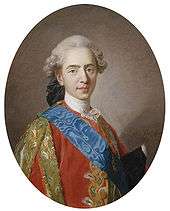
Maria Antonia formally renounced all her rights over the Habsburg domains, and on 19 April she was married by proxy to the Dauphin of France at the Augustinian Church in Vienna, with her brother Archduke Ferdinand standing in for the Dauphin.[22][23][24] On 14 May she met her husband at the edge of the forest of Compiègne. Upon her arrival in France, she adopted the French version of her name: Marie Antoinette. A further ceremonial wedding took place on 16 May 1770 in the Palace of Versailles and, after the festivities, the day ended with the ritual bedding.[25][26] The lack of consummation of the marriage plagued the reputation of both Louis-Auguste and Marie Antoinette for the next seven years.[27][28]
The initial reaction to the marriage between Marie Antoinette and Louis-Auguste was mixed. On the one hand, the Dauphine was beautiful, personable and well-liked by the common people. Her first official appearance in Paris on 8 June 1773 was a resounding success. On the other hand, those opposed to the alliance with Austria, and others, for personal reasons, had a difficult relationship with Marie Antoinette.[29]

Madame du Barry, for example, was Louis XV's mistress and had considerable political influence over him. In 1770 she was instrumental in ousting Étienne François, duc de Choiseul, who had helped orchestrate the Franco-Austrian alliance and Marie Antoinette's marriage,[30] and exiling his sister the duchesse de Gramont, one of Marie Antoinette's ladies-in-waiting. Marie Antoinette was persuaded by her husband's aunts to refuse to even acknowledge du Barry, but some saw this as a political blunder that jeopardised Austria's interests at the French court. However, Marie Antoinette's mother and the Austrian ambassador to France, comte de Mercy-Argenteau who was sending the Empress secret reports on Marie-Antoinette's behavior, put Marie Antoinette under pressure and she grudgingly agreed to speak to Madame du Barry on New Year's Day 1772.[31][32] She only said "there are a lot of people at Versailles today", but Madame du Barry was satisfied by this victory and the crisis passed.[33] Two days after the death of Louis XV in 1774, Louis XVI exiled Madame du Barry to the Abbaye de Pont-aux-Dames in Meaux, pleasing his wife and aunts.[34][35][36][37][38] Two and a half years later, at the end of October 1776, Madame du Barry's exile ended and she was allowed to return to her beloved chateau at Louveciennes, but she was never permitted to return to Versailles.[39]
Queen of France (1774–91)
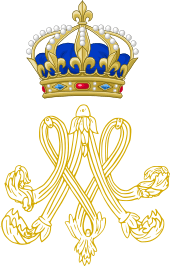
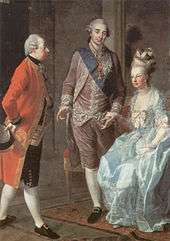
Early years (1774–78)
Upon the death of Louis XV on 10 May 1774, the Dauphin ascended the throne as King Louis XVI of France and Navarre, and Marie Antoinette became Queen of France and Navarre. At the outset, the new queen had limited political influence with her husband, who with the support of his two most important ministers, Chief Minister Maurepas and Foreign Minister Vergennes, blocked several of her candidates from taking important positions, including Choiseul,.[40][41] However, the queen did play a decisive role in the disgrace and exile of the most powerful of Louis XV's ministers, the Duke of Aiguillon.[42][43][44]
On 24 May 1774, two weeks after the death of Louis XV, her husband gave her an estate, the Petit Trianon, and free rein to renovate it; soon rumours circulated that she plastered the walls with gold and diamonds.[45]
The queen spent heavily on fashion, luxuries and gambling, though the country was facing a grave financial crisis and the population suffering. For her, Rose Bertin created dresses, hair styles such as poufs up to three feet (90 cm) high and the panache (bundle of feathers). She and her court also adopted the English fashion of dresses made of indienne (a material banned in France from 1686 until 1759), percale and muslin.[46][47] By the time of the Flour War of 1775, a series of riots against the high price of flour and bread, her reputation among the general public was no better than that of the favourites of the previous kings.
As early as 1774, Marie Antoinette began to befriend a few male admirers, such as the baron de Besenval, the duc de Coigny, and the Count Valentin Esterházy.,[48][49] and formed deep friendships with various ladies at court. Most noted was Marie-Louise, princesse de Lamballe, related to the royal family through her marriage into the Penthièvre family. On 19 September 1774, she appointed her Superintendent of her Household,[50][51] a charge she soon gave to her new favourite, the duchesse de Polignac.
In 1774, she took under her patronage her former music teacher, the German composer of operas Christoph Willibald Gluck, who remained in France until 1779.[52][53]
Motherhood, changes at court, intervention in politics (1778–81)

Amidst the atmosphere of a wave of libelles, the Holy Roman Emperor Joseph came to France incognito, under the name comte de Falkenstein, for a six-week visit during which he toured Paris extensively and was a guest at Versailles. He met his sister and her husband on 18 April 1777 at the château de la Muette, and spoke frankly to his brother-in-law, curious as to why the royal marriage had not been consummated, arriving at the conclusion that no obstacle to the couple's conjugal relations existed, save the queen's lack of interest and the king's unwillingness to exert himself in that arena.[54] In a letter to his brother Leopold, Joseph graphically described them as "a couple of complete blunderers."[55] Due to Joseph's intervention, the marriage was finally consummated in August 1777.[56] Eight months later, in April 1778, it was suspected that the queen was pregnant, which was officially announced on May 16.[57] Marie Antoinette's daughter, Marie-Thérèse Charlotte, Madame Royale, was born at Versailles on 19 December 1778.[9][58][59] The child's paternity was contested in the libelles.[60]
In the middle of the queen's pregnancy, two events occurred which had profound impact on her later life: the return of Count Axel von Fersen to Versailles for two years, and her brother's claims on the throne of Bavaria.[61] Marie Antoinette pleaded with her husband for the French to intercede on behalf of Austria. The Peace of Teschen, signed on 13 May 1779, ended the brief conflict, with the queen imposing French mediation on the demand of her mother, and Austria's gaining a territory of at least 100,000 inhabitants - a strong retreat from the early French position which was hostile towards Austria with the impression, partially justified, that the queen sided with Austria against France .[62][63]

Meanwhile, the queen began to institute changes in the customs practiced at court. Some changes were met with disapproval from the older generation, such as the abandonment of heavy make-up and the popular wide-hooped panniers. The new fashion called for a more simple feminine look, typified first by the rustic robe à la polonaise and later by the gaulle, a simple muslin dress Marie Antoinette wore in a 1783 Vigée-Le Brun portrait.[64] She also began to participate in amateur plays and musicals, starting in 1780, in a theatre built for her by Mique at the Petit Trianon.[65]
Repayment of the French debt remained a difficult problem, further exacerbated by Vergennes and also Marie Antoinette's prodding Louis XVI to involve France in Great Britain's war with its North American colonies: the queen played a very important role in supporting the American Revolution by securing Austrian and Russian support for France which resulted in the establishment of a neutral league that stopped Great Britain's attack, and by weighing in decisively for the nomination of Philippe Henri, marquis de Ségur, as Minister of War and Charles Eugène Gabriel de La Croix, marquis de Castries, Secretary of the Navy in 1780, who helped George Washington in defeating the British in the American Revolutionary War, which ended in 1783.[66]
In 1783, the queen played a decisive role in the nomination of Charles Alexandre de Calonne, a close friend of the Polignacs, as Controller-General of Finances, and of the baron de Breteuil as the Minister for the Maison du Roi (Minister of the Royal Household), making him perhaps the strongest and most conservative minister of the reign. The result of these two nominations was that Marie Antoinette's influence became paramount in government, and the new ministers rejected any major change to the structure of the old regime. More than that, the decree by de Ségur, the minister of war, requiring four quarterings of nobility as a condition for the appointment of officers, blocked the access of commoners to important positions in the armed forces, posing the concept of equality one of the main grievances and causes of the French Revolution.[67][68]
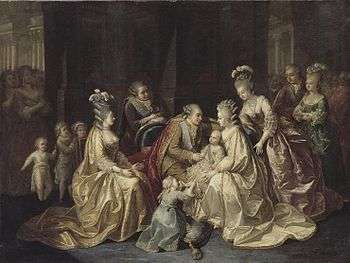
Marie Antoinette's second pregnancy ended in a miscarriage early in July 1779, as confirmed by letters between the queen and her mother, although some historians believed that she may have experienced bleeding related to an irregular menstrual cycle, which she mistook for a lost pregnancy.[69] Her third pregnancy was affirmed in March 1781, and on 22 October she gave birth to Louis Joseph Xavier François, Dauphin of France.
Empress Maria Theresa died on 29 November 1780, in Vienna. Marie Antoinette feared that the death of her mother would jeopardise the Franco-Austrian alliance (as well as, ultimately, herself), but her brother, Joseph II, Holy Roman Emperor, wrote to her that he had no intention of breaking the alliance.
A second visit from Joseph II, which had taken place in July 1781, to reaffirm the Franco-Austrian alliance and also to see his sister again, was tainted with rumours that Marie Antoinette was sending money from the French treasury to him.[70][71]
Declining popularity (1782–85)
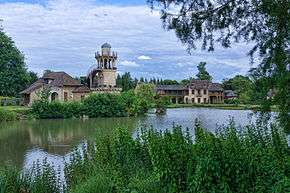



Despite the general celebration over the birth of the Dauphin, Marie Antoinette's political influence, such as it was, did greatly benefit Austria.[72] During the Kettle War, in which her brother Joseph attempted to open the Scheldt River for naval passage; Marie Antoinette succeeded in obliging Vergennes to pay a huge financial compensation to Austria. Finally, the queen was able to obtain her brother's support against Great Britain in the American Revolution and she neutralized French hostility to his alliance with Russia.[73][74]
In 1782, after the governess of the Enfants de France, the princesse de Guéméné, went bankrupt and resigned, Marie Antoinette appointed her favourite, the duchesse de Polignac, to the position.[75] This decision met with disapproval from the court, as the duchess was considered to be of too modest a birth to occupy such an exalted position. On the other hand, both the king and the queen trusted Mme de Polignac completely, gave her a thirteen-room apartment in Versailles and paid her well.[76] The entire Polignac family benefited greatly from the royal favour in titles and positions, but its sudden wealth and lavish lifestyle outraged most aristocratic families who resented the Polignacs' dominance at court, and also fueled the increasing popular disapprobation toward Marie Antoinette, mostly in Paris.[77] Mercy wrote to the Empress:"It is almost unexampled that in so short a time, the royal favour should have brought such overwhelming advantages to a family".[78]
In June 1783, Marie Antoinette's new pregnancy was announced; however, on the night of 1–2 November, her 28th birthday, she suffered a miscarriage.

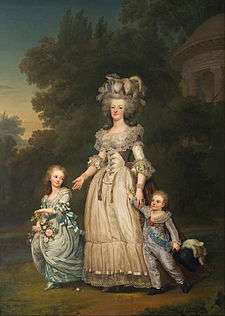
Count Axel von Fersen, after his return from America in June 1783, was accepted into the queen's private society. There were and still are claims that the two were romantically involved,[79] but since most of the correspondence between the two has been either lost or destroyed, there is no conclusive evidence of this.[80]
In 1783, the queen was busy with the creation of her "hamlet", a rustic retreat built by her favoured architect, Richard Mique, according to the designs of the painter Hubert Robert.[81] Its creation, however, caused another uproar when its cost became widely known.[82][83] Around this time, she accumulated a library of 5000 books. Those on music, often dedicated to her, were the most read, though she also liked to read history.[84][85] She sponsored the arts, in particular music, and also supported some scientific endeavours, encouraging and witnessing the first launch of a hot air balloon (Montgolfière).[86]
On 27 April 1784, Beaumarchais's play The Marriage of Figaro premiered in Paris. After initially having been banned by the king due to its negative portrayal of the nobility, the play was finally allowed to be publicly performed because of the queen's support and its overwhelming popularity at court, where secret readings of it had been given by Marie Antoinette. The play was a disaster for the image of the monarchy and aristocracy. It did inspire Mozart's Le nozze di Figaro, which premiered in Vienna on 1 May 1786.[87]
On 24 October 1784, putting the baron de Breteuil in charge of its acquisition, Louis XVI bought the Château de Saint-Cloud from the duc d'Orléans, in the name of his wife. This was unpopular, particularly with some factions of the nobility who disliked the queen, but also with a growing percentage of the population who disapproved of a Queen of France owning her private residence independently of the king; thus, the purchase of Saint-Cloud contributed to damage the image of the queen even further in the public opinion. The château's expensive price, almost 6 million livres, plus the substantial extra cost of redecorating it, ensured that there was much less money going towards repaying France's substantial debt.[88][89]
Prelude to the Revolution: Scandals and the failure of Reforms (1786–89)
On 27 March 1785, Marie Antoinette gave birth to a second son, Louis Charles, who bore the title of Duke of Normandy.[90] The fact that the birth occurred exactly nine months after Fersen's return did not escape the attention of many, leading to doubt as to the parentage of the child, and to a noticeable decline of the queen's reputation in public opinion.[91] However, the majority of Marie-Antoinette's and Louis XVII's biographers believe that the young prince was the biological son of Louis XVI, even Stefan Zweig and Antonia Fraser, who believe that Fersen and Marie Antoinette were romantically involved.[92][93][94][95][96][97][98][99] Courtiers at Versailles noted in their diaries that the date of the child's conception in fact corresponded perfectly with a period when the king and the queen had spent a lot of time together, but these details were ignored amid attacks on the queen's character.[100] These suspicions of illegitimacy, along with the continued publication of the libelles, and never-ending cavalcades of court intrigues, the actions of Joseph II in the Kettle War, the purchase of Saint-Cloud and the Diamond Necklace scandal combined to turn popular opinion sharply against the queen, and the image of a licentious, spendthrift, empty-headed foreign queen was quickly taking root in the French psyche.[101]
A second daughter, and her last child, Marie Sophie Hélène Béatrix, Madame Sophie, was born on 9 July 1786, and lived only eleven months, to 19 June 1787.
Issue
- Marie-Thérèse-Charlotte, Madame Royale (19 December 1778 – 19 October 1851)
- Louis-Joseph-Xavier-François, Dauphin (22 October 1781 – 4 June 1789)
- Louis-Charles, Dauphin after the death of his elder brother, future titular king Louis XVII of France (27 March 1785 – 8 June 1795)
- Sophie-Hélène-Béatrix, died in infancy (9 July 1786 – 19 June 1787)
The diamond necklace scandal
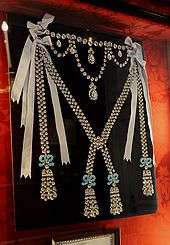
Marie-Antoinette began to abandon her more carefree activities to become increasingly involved in politics in her role as "Queen of France".[102] By showing to the public her attention to the education and care of her children, the queen sought to improve the dissolute image she had acquired in 1785 from the "Diamond Necklace Affair", in which public opinion had falsely accused her of criminal participation in defrauding the jewelers Boehmer and Bassenge of the cost of a very expensive diamond necklace they had created originally for Madame du Barry. The main actors of the scandal were the Cardinal de Rohan, prince de Rohan-Guéméné, Great Almoner of France, and Jeanne de Valois-Saint-Rémy, comtesse de La Motte, a descendant of an illegitimate child of Henry II of France of the House of Valois. Marie Antoinette had a profound dislike for Rohan since the time he had been the French ambassador to Vienna when she was a child. Despite his high clerical position at the Court, she never addressed a word to him. Others involved were Nicole Legay, alias baronne d'Oliva, a prostitute who happened to be a lookalike of Marie Antoinette, Rétaux de Villette, a forger, Alessandro Cagliostro, an Italian adventurer, and the comte de La Motte, Jeanne de Valois' husband. Mme de La Motte tricked Rohan into buying the necklace as a gift to Marie-Antoinette, in order for him to get into the favors of the queen. When the affair was discovered, those involved (except de La Motte and Réaux de Villette who managed to flee) were arrested, tried, convicted and either imprisoned or exiled. The only one imprisoned was Mme de La Motte, who was given a life sentence to Pitié-Salpêtrière Hospital, which also served as a prison for women. Judged by the Parlement, Rohan was found innocent of any wrongdoing (which he was), and allowed to leave the Bastille. Marie Antoinette, who had insisted on the arrest of the Cardinal was dealt a heavy personal blow, as was the monarchy, and despite the fact that the guilty parties were tried and convicted, the affair proved to be extremely damaging to her reputation, which never recovered from it.
Failure of political and financial reforms
Suffering from an acute case of depression, the king began to seek the advice of his wife. In her new role and with increasing degree of power as a politically viable entity, the queen tried to help the situation brewing between the assembly and the king.[103] This change of the queen's political position signalled the end of the Polignacs' influence and their impact on the finances of the Crown.
Continuing deterioration of the financial situation, despite cutbacks to the royal retinue and court expenses, ultimately forced the king, the queen and the Minister of Finance, Calonne, at the urging of Vergennes, to call the Assembly of Notables, after a hiatus of 160 years. The assembly was held to attempt passing necessary financial reforms, but the Parlements refused to cooperate. The first meeting took place on 22 February 1787, (nine days after the death of Vergennes on 13 February). Marie Antoinette did not attend the meeting and her absence resulted in accusations that the queen was trying to undermine its purpose.[104][105] The Assembly was a failure: it did not pass any reforms and, instead, fell into the pattern of defying the king. On the urging of the queen, Louis XVI dismissed Calonne on 8 April 1787.[103]
On 1 May 1787, Étienne Charles de Loménie de Brienne, the archbishop of Toulouse and one of the queen's political allies, was appointed by the king, on Marie Antoinette's urging, to replace Calonne, first as the Controller-General of Finances and then as Prime Minister. He began to institute more cutbacks at court, while trying to restore the royal absolute power weakened by parliaments.[106] Brienne, though, was not able to improve the financial situation, and since he was the queen's ally, this failure adversely affected her political position. The continued poor financial climate of the country resulted in the 25 May dissolution of the Assembly of Notables because of its inability to get things done, and the lack of solutions was blamed on the queen.[107]
France's financial problems were the result of a combination of factors: several expensive wars; a large royal family whose expenditures were paid for by the state; and an unwillingness on the part of most members of the privileged classes, aristocracy and clergy, to help defray the costs of the government out of their own pockets by relinquishing some of their financial privileges. As a result of the public perception that she had single-handedly ruined the national finances, Marie Antoinette was given the nickname of "Madame Déficit" in the summer of 1787.[108] While sole fault for the financial crisis did not lie with her, Marie Antoinette was the biggest obstacle to any major reform effort. She had played a decisive role in the disgrace of the reformer Ministers of Finance, Turgot (in 1776), and Jacques Necker (first dismissal in 1781). If the secret expenses of the queen were taken into account, the expense of the court was much higher than the official estimate of 7% of the state budget.[109]
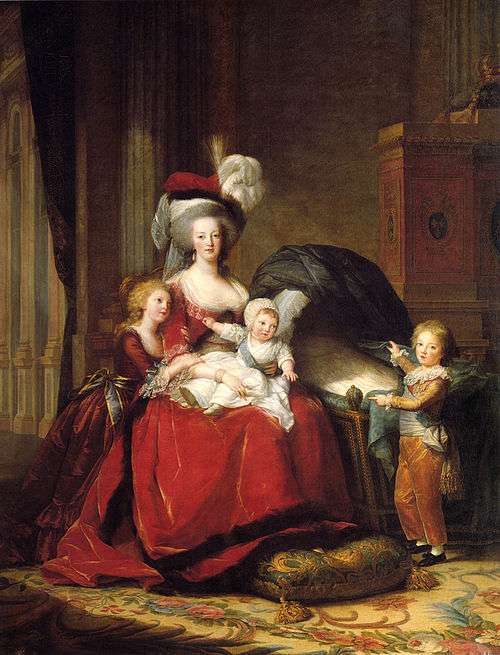
The queen attempted to fight back with propaganda portraying her as a caring mother, most notably in the painting by Élisabeth Vigée Le Brun exhibited at the Royal Académie Salon de Paris in August 1787, showing her with her children.[110][111] Around the same time, Jeanne de Valois-Saint-Rémy escaped from prison and fled to London, where she published damaging slander concerning her supposed amorous affair with the queen.[112]
The political situation in 1787 worsened when, on Marie Antoinette's urging, on 15 August the Parlement was exiled in Troyes. It further deteriorated when Louis XVI tried to use a lit de justice on 11 November to impose legislation. The new duc d'Orléans publicly protested the king's actions, and was subsequently exiled to his estate at Villers-Cotterêts.[113] The May Edicts issued on 8 May 1788 were also opposed by the public and parliaments. Finally, on 8 August, Louis XVI announced his intention to bring back the Estates General, the traditional elected legislature of the country, which had not been convened since 1614.[114]
While from late 1787 up to his death in June 1789, Marie-Antoinette's primary concern was the continued deterioration of the health of the Dauphin, who suffered from tuberculosis,[115] she was directly involved with the exile of the Parlement, the May Edicts and the announcement regarding the Estates General; she did participate in the King Council, the first queen to do this in over 175 years (since Marie de' Medici had been named Chef du Conseil du Roi, between 1614 and 1617), and she was making the major decisions behind the scene and in the King Council.
Marie Antoinette was instrumental in the recall of Jacques Necker as Finance Minister on 26 August, a popular move, even though she herself was worried that the recall would again go against her if Necker proved unsuccessful in reforming the country's finances, and she accepted Necker's proposition to double the representation of the Tiers État in an attempt to check the power of the aristocracy[116][117]
On the eve of the opening of the Estates General, the queen attended the mass celebrating its return. From time of its very opening on 5 May 1789, the fracture between the democratic Third Estate (consisting of bourgeois and radical aristocrats), and the conservative nobility of the Second Estate widened, and Marie Antoinette knew that her rival, the duc d'Orléans, who had given money and bread to the people during the winter, would be acclaimed by the crowd, much to her detriment.[118]
The death of the Dauphin on 4 June, which deeply affected his parents, was virtually ignored by the French people,[119] who were instead preparing for the next meeting of the Estates General and hoping for a resolution to the bread crisis. As the Third Estate declared itself a National Assembly and took the Tennis Court Oath, and as people either spread or believed rumors that the queen wished to bathe in their blood, Marie Antoinette went into mourning for her eldest son.[120] Her role was decisive in urging the king to remain firm and to not concede to popular demands for reforms. In addition, she was showing her determination to use force to crush the forthcoming revolution.[121][122]
The French Revolution before Varennes (1789–91)

The situation escalated on 20 June as the Third Estate, which had been joined by several members of the clergy and radical nobility, found the door to its appointed meeting place closed by order of the king. It thus met at the tennis court in Versailles and took the Tennis Court Oath not to separate before it had given a constitution to the nation.
On 11 July, on Marie Antoinette's urging, Necker was dismissed to be replaced by Breteuil, the queen's choice to crush the Revolution with mercenary Swiss troops under the command of one of her favorites, Pierre Victor, baron de Besenval de Brünstatt.[123][124][125] At the news, Paris was besieged by riots which culminated in the storming of the Bastille on 14 July,[126][127] and on 15 July Gilbert du Motier, Marquis de Lafayette was named commander-in-chief of the newly formed Garde nationale.[128][129]
In the days following the storming of the Bastille, for fear of assassination, and ordered by the king, the emigration of members of the high aristocracy began, with the departure of the comte d'Artois, the Condés, cousins of the king,[130] and the unpopular Polignacs on 17 July. Marie Antoinette, whose life was as much in danger, remained by the king whose power was gradually being taken away by the National Constituent Assembly.[128][131][132]
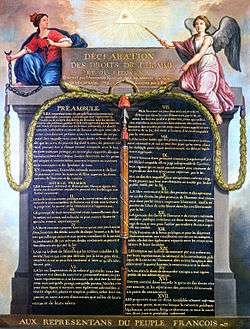
The abolition of feudal privileges by the National Constituent Assembly on 4 August 1789, and the Declaration of the Rights of Man and of the Citizen (La Déclaration des Droits de l'Homme et du Citoyen), drafted by La Fayette with the help of Thomas Jefferson, and adopted on 26 August, led the way to the Constitutional Monarchy (4 September 1791 – 21 September 1792).[133][134] Despite these dramatic changes, life at court continued, while the situation in Paris was becoming critical because of bread shortages in September. On 5 October, a crowd from Paris descended upon Versailles and forced the royal family to move to the Tuileries Palace in Paris, where they lived under a form of house arrest under the watch of La Fayette's Garde nationale, while the comte de Provence and his wife were allowed to reside in the Petit Luxembourg, where they remained until going into exile on 20 June 1791.[135]
Marie Antoinette continued performing charitable functions, attending religious ceremonies, but mostly dedicated her time to her children.[136] She also played an important political, albeit not public, role between 1789 and 1791, in which time she had a complex set of relationships with several key actors of the early period of the French Revolution. One of the most important was Necker, the "Prime Minister of Finances" (Premier ministre des finances).[137] Despite her dislike of him, she played a decisive role in his return to office; however, she blamed him for his supporting the Revolution, and did not regret his resignation in 1790.[138][139]
La Fayette, one of the former military leaders in the American War of Independence (1775–83), served as the warden of the royal family in his position as commander-in-chief of the Garde nationale. Despite his dislike of the queen - he detested her as much as she detested him and, at one time, had even threatened sending her to a convent - he was persuaded by the mayor of Paris, Jean Sylvain Bailly, to work in collaboration with her, and even allowed her to see Fersen a number of times. He even went as far as exiling the Duke of Orléans, who was accused by the queen of fomenting trouble. His relation with the king was more cordial: being a liberal aristocrat, he did not want the fall of the monarchy but the establishment of a liberal one, similar to that of the United Kingdom, based on collaboration between the king and the people, as was to be defined in the Constitution of 1791.
.jpg)
Despite her attempts to remain out of the public eye, Marie Antoinette was falsely accused in the libelles of conducting an affair with La Fayette, whom she loathed,[140] and, as was published in "Le Godmiché Royal" (translated, "The Royal Dildo"), on having a sexual relationship with the English Baroness 'Lady Sophie Farrell' of Bournemouth, a well-known lesbian of the time. Publication of such calumnies continued to the end, climaxing at her trial with that of incest with her son. There is no evidence to support the accusations.
Mirabeau
A significant achievement for Marie Antoinette in that period was the establishment of an alliance with Honoré Gabriel Riqueti, comte de Mirabeau, the most important lawmaker in the assembly. Like La Fayette, Mirabeau was a liberal aristocrat. He had joined the tiers état, and was not against the monarchy, but wanted to reconcile the monarchy with the Revolution. He also wanted to be a minister and was not immune to corruption. On the advice of Mercy, Marie Antoinette opened secret negotiations with him and both agreed to meet in secret at the château of Saint-Cloud on 3 July 1790, where the royal family was allowed to spend the summer, free of the radical elements who watched their every move in Paris.[141][142] At the meeting, Mirabeau was much impressed by the queen, and remarked in a letter to the comte de La Marck that she was the only man the king had by him: La reine est le seul homme que le roi ait auprès de lui.[143] A deal was reached turning Mirabeau into one of her political allies: Marie Antoinette promised to pay him 6000 livres per month and one million if he succeeded in his mission to restore the king's authority.[144]
The only time the royal couple returned to Paris in that period was on 14 July, to attend the Fête de la Fédération, the official ceremony held at the Champ de Mars in commemoration of the fall of the Bastille one year earlier. At least 300,000 persons participated from all over France including 18,000 national guards, with Talleyrand, bishop of Autun, celebrating a mass at the autel de la patrie ("altar of the fatherland"). At the event, the king was greeted with loud cheers of "Long Live The King ", especially when he took the oath to protect the Nation and to enforce the laws voted by the Constitutional Assembly. There were even cheers to the queen, particularly when she presented the Dauphin to the public.[145][146]
Mirabeau sincerely wanted to reconcile the queen with the people, and she was happy to see him restoring much of the king's powers, such as his authority over foreign policy, and the right to declare war. Over the objections of La Fayette and his allies, the king was given a suspensive veto allowing him to veto any laws for a period of four years. With time, Mirabeau would support the queen even more, going as far as to suggest Louis XVI "adjourn" to Rouen or Compiègne.[147] However, this leverage with the Assembly ended with the death of Mirabeau in April 1791, despite the attempt of several moderate leaders of the Revolution to contact the queen to establish some kind of cooperation with her.
Civil Constitution of the Clergy
In March 1791, Pope Pius VI had condemned the Civil Constitution of the Clergy, reluctantly signed by Louis XVI, which reduced the number of bishops from 132 to 93, imposed the election of bishops and all members of the clergy by departmental or district assemblies of electors, and finally reduced the Pope's authority over the Church. Religion played an important role in the life of Marie Antoinette and Louis XVI, both raised in the Roman Catholic faith. The queen's political ideas and her belief in the absolute power of monarchs were based on France's monarchy long established on the divine right of kings. On 18 April, as the royal family was ready to leave for Saint-Cloud to attend Easter mass celebrated by a refractory priest, a crowd, soon joined by the Garde nationale (disobeying La Fayette's orders), kept it from leaving Paris, and prompting Marie Antoinette to declare to La Fayette that she and her family were no longer free. This incident fortified her in her determination to leave Paris; however, both for affective and political reasons, not alone, but with her family, and even the king, who had been hesitant, accepted his wife's decision to flee with the help of foreign powers and counter revolutionary forces.[148][149][150] Fersen and Breteuil (who represented her in the courts of Europe) were put in charge of the escape plan, while Marie Antoinette continued her negotiations with some moderate leaders of the French Revolution.[151][152]
Flight, arrest at Varennes and return to Paris (21–25 June 1791)

There had been several plots designed to help the royal family escape, which the queen had rejected because she would not leave without the king, or which had ceased to be viable because of the king's indecision. Once Louis XVI finally did commit to a plan, its poor execution was the cause of its failure. In an elaborate attempt, known as the Flight to Varennes, to reach the royalist stronghold of Montmédy, some members of the royal family were to pose as the servants of (the imaginary) Mme de Korff, a wealthy Russian baroness, in the role held by Louise-Élisabeth de Croÿ de Tourzel, governess of the royal children.

After many delays, the escape ultimately occurred on 21 June 1791, but the entire family was arrested twenty-four hours later at Varennes and taken back to Paris within a week. The escape attempt destroyed much of the remaining support of the population for the king[153][154]
Upon learning of the capture of the royal family, the National Constituent Assembly sent three representatives, Antoine Barnave, Jérôme Pétion de Villeneuve and Charles César de Fay de La Tour-Maubourg to Varennes to escort Marie Antoinette and her family back to Paris, where they were jeered and insulted by the people as never before. The prestige of the French monarchy had never been at such a low level. During the trip, Barnave, the representative of the moderate party in the Assembly, protected Marie Antoinette from the crowds, and even Pétion took pity on the royal family. Brought safely back to Paris, they were met with total silence from the crowd. Thanks to Barnave, the royal couple was not brought to trial and was publicly exonerated of any crime in relation with the attempted escape.[155][156]
During the night of 21–22 June, the queen's hair had, according to Mme Campan, Marie Antoinette's first lady-of-the-bedchamber, "in one night it turned white as those of a seventy-year old woman." (En une seule nuit ils étaient devenus blancs comme ceux d'une femme de soixante-dix ans.)[157]
Radicalization of the Revolution after Varennes (1791–92)

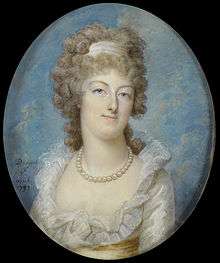
After their return from Varennes, and until the storming of the Tuileries on 10 August 1792, the queen, her family and entourage were held by the Garde nationale under tight surveillance within the Tuileries, where the royal couple was guarded night and day. Four guards accompanied her wherever she went, and her bedroom door had to be left open at night. Her health also began to deteriorate, thus further reducing her physical activities.[158][159]
On 17 July 1791, with the support of Barnave and his friends, La Fayette's Garde nationale opened fire on the crowd who had assembled on the Champ de Mars to sign a petition demanding the deposition of the king. The estimated number of those killed varies between 12 and 50. La Fayette's reputation never recovered from the event and, on 8 October, he resigned as commander of the Garde nationale. Always refusing his help, Marie Antoinette played a decisive role in defeating him in his aims to become the mayor of Paris in November 1791.[160]
As her correspondence shows, while Barnave was taking great political risks with the belief the queen was his political ally, and had managed, despite her unpopularity, to secure a moderate majority ready to work with her, Marie Antoinette was not sincere in her cooperation with the moderate leaders of the French Revolution, which ultimately ended any chance to establish a moderate government.[161] Moreover, the view that the unpopular queen was controlling the king further degraded the royal couple's standing with the people, which the Jacobins successfully exploited after their return from Varennes to advance their radical agenda to abolish the monarchy.[162] This situation lasted until the spring of 1792.[163][164]
Marie Antoinette kept hoping that the military coalition of the European kingdoms would succeed in crushing the Revolution. She counted mostly on the support of her Austrian family. After the death of her brother Joseph in 1790, his successor, Leopold was willing to support her, but only to a limited degree. However, upon Leopold's death in 1792, his son, Francis, a conservative ruler, was ready to support the cause of the French royal couple because he feared the consequences of the French Revolution and its ideas on the monarchies of Europe and, more particularly, on Austria's influence in the continent.
Barnave had advised the queen to call back Mercy, who had played such an important role in her life before the Revolution, but Mercy had been appointed to another foreign diplomatic position and could not return to France. At the end of 1791, ignoring the danger she faced, the princesse de Lamballe, who was in London, returned to the Tuileries. As for Fersen, in February 1792, despite the strong restriction imposed on her, he was able to see the queen a final time.[165]
Events leading to the abolition of the monarchy on 10 August 1792 - Temple

Leopold's and Francis II's aggressive actions on Marie Antoinette's behalf led to France's declaration of war on Austria on 20 April 1792. This resulted in the queen being viewed as an enemy, even though she was against Austrian claims to French territories on European soil. That summer, the situation was compounded by multiple defeats of the French armies by the Austrians, in part because of Marie Antoinette passed military secrets[166] to Austria. In addition, at the insistence of his wife, Louis XVI vetoed several measures that would have further restricted his power, earning the royal couple the nicknames "Monsieur Veto" and "Madame Veto".[167][168] nicknames then prominently featured in different contexts, including La Carmagnole.
Barnave remained the most important advisor and supporter of the queen, who was willing to work with him as long as he followed her demands, which he did to a large extent. Barnave and the moderates made up about 260 lawmakers in the new Legislative Assembly; the radicals numbered around 136, and the rest around 350. Initially, the majority was with Barnave, but the queen's policy led to the radicalization of the Assembly and the moderates lost control of the legislative process. The moderate government collapsed in April 1792 and was replaced by a radical majority headed by the Girondins. The Assembly then passed a series of laws concerning the Church, the aristocracy and the formation of new national guard units: all were vetoed by Louis XVI. While Barnave's section had fallen to 120 members, the new Girondin majority controlled the legislative assembly with 330 members. The two strongest members of that government were Jean Marie Roland, who was minister of interior, and General Dumouriez, the minister of foreign affairs. Dumouriez sympathised with the royal couple and wanted to save them; however, he was rebuffed by the queen.[169][170]
Marie Antoinette's actions in refusing to collaborate with the Girondins, in power between April and June 1792, led them to denounce the treason of the Austrian comity, a direct allusion to the queen. After Madame Roland sent a letter to the king denouncing the queen's role in these matters, pushed by the queen, Louis XVI sacked the government, thus losing his majority in the Assembly. Dumouriez resigned and refused a post in any new government. At this point, the tide within the population and political parties against the royal authority intensified, while Marie Antoinette encouraged the king to veto the new laws voted by the Legislative Assembly in 1792.[171] In August 1791, the Declaration of Pillnitz threatened to invade France. This led in turn to the French declaration of war in April 1792, which led to the French Revolutionary Wars and to the events of August 1792, which ended the monarchy.[172]

On 20 June 1792, "a mob of terrifying aspect" broke into the Tuileries, made the king wear the bonnet rouge (red Phrygian cap) to show his loyalty to the Republic, insulted Marie Antoinette, accusing her of betraying France, and threatened her life. In consequence, the queen asked Fersen to push the foreign powers to activate their invasion of France, and to issue a manifesto in which the foreign powers threatened to destroy Paris if anything happened to the royal family. The Brunswick Manifesto, issued on 25 July 1792, triggered the events of 10 August[173] when the approach of an armed mob on its way to the Tuileries Palace forced the royal family to seek refuge at the Legislative Assembly. Ninety minutes later, the palace was invaded by the mob who massacred the Swiss Guards.[174][175] On 13 August, the royal family was imprisoned in the tower of the Temple in the Marais under conditions considerably harsher than those of their previous confinement in the Tuileries.[176]
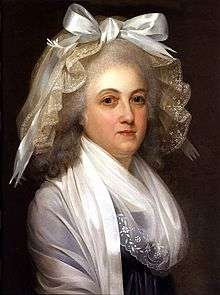
A week later, several of the royal family's attendants, among them the princesse de Lamballe, were taken in for interrogation by the Paris Commune. Transferred to the La Force prison, after a rapid judgment, Marie Louise de Lamballe was savagely killed on 3 September. Her head was affixed on a pike and marched through the city to the Temple for the queen to see. Marie Antoinette was kept from seeing it, but fainted upon learning of it.[177][178]
On 21 September 1792, the fall of the monarchy was officially declared, and the National Convention became the governing body of the French Republic. The royal family was re-styled as the non-royal "Capets". Preparations began for the trial of the king in a court of law.[179]
Louis XVI's trial and execution

Charged with undermining the First French Republic, Louis XVI was separated from his family and tried in December. He was found guilty by the Convention led by the Jacobins who rejected the idea of keeping him as a hostage. On 15 January 1793, by vote with a majority of one voice, that of Philippe Égalité, he was condemned to death by guillotine and was executed on 21 January 1793.[180][181]
Marie Antoinette in the Temple
The queen, now called "Widow Capet", plunged into deep mourning. She still hoped her son, Louis XVII, whom the comte de Provence had, from exile, recognised as Louis XVI's successor, would one day rule France. The royalists and the refractory clergy, including those preparing the insurrection in Vendée, supported Marie Antoinette and the return to the monarchy. Throughout her imprisonment and up to her execution, Marie-Antoinette could count on the sympathy of conservative factions and social-religious groups which had turned against the Revolution, and also on wealthy individuals ready to corrupt republican officials in order to facilitate her escape;[182] however, all plots failed. Prisoners in the tower of the Temple, Marie Antoinette, her children and Élisabeth were insulted, some of the guards going as far as smoking in the ex-queen's face. Strict security measures were taken to assure that Marie Antoinette was not able to communicate with the outside world; but, despite these measures, several of the guardians were open to corruption, and a line of communication was kept with the outer world.
After Louis' execution, Marie Antoinette's fate became a central question of the National Convention. While some advocated for her death, others proposed exchanging her for French prisoners of war or for a ransom from the Holy Roman Emperor. Thomas Paine advocated exile to America.[183] In April 1793, during the Reign of Terror, a Committee of Public Safety dominated by Robespierre was formed, and men such as Jacques Hébert began to call for Antoinette's trial. By the end of May, the Girondins had been chased from power.[184] Calls were also made to "retrain" the eight-year old Louis XVII, to make him pliant to revolutionary ideas. To carry this out, Louis Charles was separated from his mother on 3 July after a heartwrenching struggle during which his mother fought in vain to retain her son, who was handed to Antoine Simon, a cobbler, and representative of the Paris Commune. Until her removal from the Temple, Marie Antoinette spent hours trying to catch a glimpse of her son, who, within weeks, had been made to turn against her, accusing his mother of wrongdoings.[185]

Conciergerie
On the night of 1 August, at 1:00 in the morning, Marie Antoinette was transferred from the Temple to an isolated cell in the Conciergerie as 'Prisoner n° 280'. Leaving the tower without bending, she banged her head against the lintel of the door, which prompted one of her guards to ask her if she was hurt, to which she answered: "No! Nothing now can hurt me."[186] This was the most difficult period of her captivity. She was under constant surveillance, with no privacy. The "Carnation Plot" (Le complot de l'œillet), an attempt to help her escape at the end of August, was foiled due to the inability to corrupt all the guards.[187] She was attended by Rosalie Lamorlière, who cared for her as much as and as well as she could. At least once, she received the visit of a Catholic priest.[188][189]
Trial and execution (14–16 October 1793)

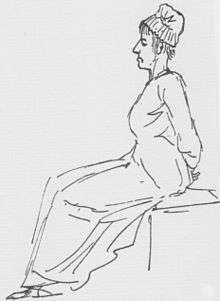
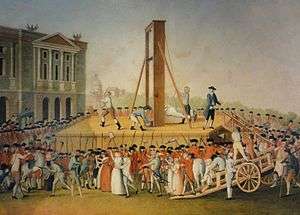
Marie Antoinette was tried by the Revolutionary Tribunal on 14 October 1793.
Some historians believe the outcome of the trial had been decided in advance by the Committee of Public Safety around the time the Carnation Plot was uncovered.[190] She and her lawyers were given less than one day to prepare her defense. Among the accusations, many previously published in the libelles, were: orchestrating orgies in Versailles, sending millions of livres of treasury money to Austria, planning the massacre of the "gardes françaises" (National Guards) in 1792,[191] declaring her son to be the new king of France, and—by her son Louis Charles himself (pushed by radical elements who controlled him)—of incest. This last accusation drew an emotional response from Marie Antoinette, who refused to respond to this charge and, instead, called on all mothers present in the room: their reaction brought her comfort since these women were not sympathetic to her.[192][193]
Early on 16 October, Marie Antoinette was declared guilty of the three main charges against her: depletion of the national treasury, conspiracy against the internal and external security of the State, intelligence with the enemy, this one alone being enough to condemn her to death.[194] At worst, she and her lawyers had expected life imprisonment.[195] In the hours left to her, she composed a letter to her sister-in-law, Madame Élisabeth, affirming her clear conscience, her Catholic faith, and her love and concern for her children. The letter did not reach Élisabeth.[196] Preparing for her execution, she had to change clothes in front of her guards. She put on a plain white dress, white being the color worn by widowed queens of France. Her hair was shorn, her hands bound painfully behind her back and she was leashed with a rope. Unlike her husband, who had been taken to his execution in a carriage (carrosse), she had to sit in an open cart (charrette) for the hour it took from the Conciergerie via the rue Saint-Honoré thoroughfare to reach the guillotine erected in Place de la Révolution, (present-day Place de la Concorde).[197] She maintained her composure, despite the insults of the jeering crowd. For her final confession, a constitutional priest was assigned to her. He sat by her in the cart, and she ignored him all the way to the scaffold.[198][199]
Marie Antoinette was guillotined at 12:15 p.m. on 16 October 1793.[200][201] Her last words were "Pardon me, sir, I meant not to do it", to Henri Sanson the executioner, whose foot she had accidentally stepped on after climbing to the scaffold. Her body was thrown into an unmarked grave in the Madeleine cemetery located close by, rue d'Anjou. Because of saturation, the cemetery was closed the following year, on 25 March 1794.[202]
Both Marie Antoinette's and Louis XVI's bodies were exhumed on 18 January 1815, during the Bourbon Restoration, when the comte de Provence had ascended the newly reestablished throne as Louis XVIII, King of France and of Navarre. Christian burial of the royal remains took place three days later, on 21 January, in the necropolis of French kings at the Basilica of St Denis.[203]
Legacy
Long after her death, Marie Antoinette remains a major historical figure linked with conservatism, the Catholic Church, wealth, and fashion. She has been the subject of a quantity of books, films and other forms of media. Politically engaged authors have deemed her the quintessential representative of class conflict, western aristocracy and absolutism. Some of her contemporaries, such as Jefferson, attributed to her the start of the French Revolution.[204] For others, Marie Antoinette was a victim of her family ambition and the general situation in France. However, even her critics have recognized her qualities as a mother and her courage in dying.
In popular culture
The phrase "Let them eat cake" is often attributed to Marie Antoinette, but there is no evidence she ever uttered it, and it is now generally regarded as a "journalistic cliché".[205] This phrase originally appeared in Book VI of the first part (finished in 1767, published in 1782) of Jean-Jacques Rousseau's putative autobiographical work, Les Confessions: "Enfin je me rappelai le pis-aller d'une grande princesse à qui l'on disait que les paysans n'avaient pas de pain, et qui répondit: Qu'ils mangent de la brioche" ("Finally I recalled the stopgap solution of a great princess who was told that the peasants had no bread, and who responded: 'Let them eat brioche'"). Apart from the fact that Rousseau ascribes these words to an unknown princess, vaguely referred to as a "great princess", the purported writing date precedes Marie Antoinette's arrival in France. Some think that he invented it altogether.[206]
In the United States, expressions of gratitude to France for its help in the American Revolution included the naming of the city of Marietta, Ohio, founded in 1788. The Ohio Company of Associates chose the name Marietta after an affectionate nickname for Marie Antoinette.[207] It can be also seen how her life has made for the production of many movies, from regal French movies to popular American movies, casting famous actors and actresses, one movie being "Marie Antoinette"[208]
Ancestry
Issue
| Name | Portrait | Lifespan | Notes |
|---|---|---|---|
| Marie Thérèse Charlotte Madame Royale |
 |
19 December 1778 - 19 October 1851 |
Married her cousin, Louis Antoine, Duke of Angoulême, the eldest son of the future Charles X of France. No issue. |
| Louis Joseph Xavier François Dauphin de France |
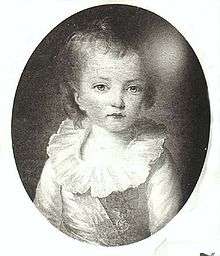 |
22 October 1781 - 4 June 1789 |
Died in childhood. |
| Louis XVII of France (Nominally) King of France and Navarre |
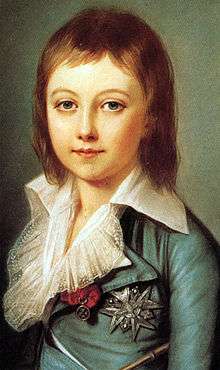 |
27 March 1785 - 8 June 1795 |
Died in childhood; no issue. He was never officially king, nor did he rule. His title was bestowed by his royalist supporters and acknowledged implicitly by his uncle's later adoption of the regnal name Louis XVIII rather than Louis XVII, upon the restoration of the Bourbon monarchy in 1814. |
| Sophie Hélène Béatrix |
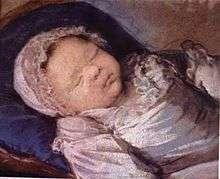 |
9 July 1786 - 19 June 1787 |
Died in childhood. |
See also
References
Notes
- ↑ Jones, Daniel (2003) [1917], Peter Roach, James Hartmann and Jane Setter, eds., English Pronouncing Dictionary, Cambridge: Cambridge University Press, ISBN 3-12-539683-2
- ↑ C. f. "It is both impolitic and immoral for palaces to belong to a Queen of France" (part of a speech by a councilor in the Parlement de Paris, early 1785, after Louis XVI bought the Château de Saint-Cloud in her name), quoted in Castelot 1957, p. 233
- ↑ C.f. the following quote: "She (Marie Antoinette) thus obtained promises from Louis XVI which were in contradiction with the Council's (of Louis XVI's ministers) decisions", quoted in Castelot 1957, p. 186
- ↑ Fraser 2002, p. 5
- ↑ Fraser 2002, pp. 5–6
- ↑ Michel de Decker: Marie-Antoinette, les dangereuses liaisons de la reine, France Loisirs, 2005, p. 12.
- ↑ Marie Célestine Amélie de Ségur d'Armaillé: Marie-Thérèse et Marie-Antoinette, Didier, 1870, p. 47.
- ↑ Lever 2006, p. 10
- 1 2 Fraser 2001, pp. 22–23,166–170
- ↑ Michel de Decker: Marie-Antoinette, les dangereuses liaisons de la reine, France Loisirs, 2005, p. 14.
- ↑ Philippe Delorme: Marie-Antoinette. Épouse de Louis XVI, mère de Louis XVII, Pygmalion Éditions, 1999, p. 13.
- ↑ Michel de Decker: Marie-Antoinette, les dangereuses liaisons de la reine, France Loisirs, 2005, p. 15.
- ↑ Marie Célestine Amélie de Ségur d'Armaillé: Marie-Thérèse et Marie-Antoinette, Didier, 1870, p. 34.
- ↑ Évelyne Lever: C'était Marie-Antoinette, Fayard, 2006, p. 14.
- 1 2 Cronin 1989, p. 45
- ↑ France Loisirs, Michel de Decker, 2005, p.16
- ↑ Fraser 2002, pp. 32–33
- ↑ France Loisirs, Michel de Decker, 2005, p.17
- ↑ Cronin 1989, p. 46
- 1 2 3 Weber 2007
- ↑ de Decker, Michel, France Loisirs, 2005, p. 20.
- ↑ Fraser 2001, pp. 51–53
- ↑ Pierre Nolhac La Dauphine Marie Antoinette,1929, pp. 46–48
- ↑ France Loisirs, Michel de Decker, 2005, p. 21.
- ↑ Fraser 2001, pp. 70–71
- ↑ Nolhac 1929, pp. 55–61
- ↑ Fraser 2001, p. 157
- ↑ Alfred et Geffroy D'Arneth & Correspondance Secrete entre Marie-Therese et le Comte de Mercy-Argenteau,vol 3 1874, pp. 80–90,110–115
- ↑ Cronin 1974, pp. 61–63
- ↑ Cronin 1974, p. 61
- ↑ Fraser 2001, pp. 80–81
- ↑ ALfred and Geffroy d'Arneth 1874, pp. 65–75
- ↑ Lever 2006
- ↑ Fraser, Marie Antoinette, 2001, p. 124.
- ↑ Jackes Levron & Madame du Barry 1973, pp. 75–85
- ↑ Evelyne Lever & Marie Antoinette 1991, pp. 124
- ↑ Goncourt, Edmond de, La Du Barry, Ed. G. Charpentier, Paris, 1880, pp. 195-196
- ↑ Lever, Evelyne, Louis XV, Fayard, Paris, 1985, p. 96
- ↑ Vatel, Charles, Histoire de Madame du Barry: d'après ses papiers personnels et les documents d'archives, Paris, 1883, p. 410
- ↑ Fraser 2001, pp. 136–137
- ↑ Arneth and Geffroy ii & 1874 pp475-480
- ↑ Castelot, André, Marie-Antoinette, Librairie académique Perrin, Paris, 1962, pp. 107-108
- ↑ Fraser 2001, pp. 124–127
- ↑ Lever Marie Antoinette 1991, pp. 125
- ↑ Cronin 1974, p. 215
- ↑ Fashion, the mirror of history, page 190, Michael Batterberry, Ariane Ruskin Batterberry, Greenwich House, 1977. ISBN 978-0-517-38881-5
- ↑ Fraser 2001, pp. 150–151
- ↑ Fraser 2001, pp. 140–145
- ↑ Arneth and Geffroy i 1874, pp. 400–410
- ↑ Fraser 2001, pp. 129–131
- ↑ Fraser 2001, pp. 131–132; Bonnet 1981
- ↑ Fraser 2001, pp. 111–113
- ↑ Howard Patricia, Gluck 1995, pp. 105–115,240–245
- ↑ Lever, Evelyne, Louis XVI, Fayard, Paris, 1985, pp. 289-291
- ↑ Cronin 1974, pp. 158–159
- ↑ Cronin 1974, p. 159
- ↑ Fraser 2001, pp. 160–161
- ↑ Cronin 1974, p. 161
- ↑ Hibbert 2002, p. 23
- ↑ Fraser 2001, p. 169
- ↑ Cronin 1974, pp. 162–164
- ↑ Fraser 2001, pp. 158–171
- ↑ Arneth and Geoffroy,iii 1874, pp. 168–170,180–182,210–212
- ↑ Cronin 1974, pp. 127–128
- ↑ Fraser 2001, pp. 174–179
- ↑ Fraser 2001, pp. 152,171,194–195
- ↑ Fraser & 2001 pp218-220
- ↑ Price Munro & Preserving the Monarchy: The Comte de Vergennes, 1774–1787 1995, pp. 30–35,145–150
- ↑ Meagen Elizabeth Moreland: The Performance of Motherhood in the Correspondence of Madame de Sévigné, Marie-Thérèse of Austria and Joséphine Bonaparte to their Daughters - Chapter I Contextualizing the correspondence, p. 11 [retrieved 1 October 2016].
- ↑ Fraser 2001, pp. 184–187
- ↑ Price 1995, pp. 55–60
- ↑ Fraser, pp.232-6
- ↑ Lettres de Marie Antoinette, Le Marquis de Beaucourt & 1895 Vol ii, pp. 42–44
- ↑ Lever, Marie Antoinette 1991, pp. 350–353
- ↑ Cronin 1974, p. 193
- ↑ Fraser 2001, pp. 198–201
- ↑ Munro Price & The Road to Versailles 2003, pp. 14–15,72
- ↑ Zweig Stephan & Marie Antoinette 1938, pp. 121
- ↑ Farr, Evelyn, Marie Antoinette and Count Fersen: Untold Love Story
- ↑ Fraser 2001, p. 202
- ↑ Lever 2006, p. 158
- ↑ Fraser, pp=206-208
- ↑ Gutwirth,Madelyn, The Twilight of the Goddesses: women and representation in the French revolutionary era 1992, pp. 103,178–185,400–405
- ↑ Fraser 2001, p. 208
- ↑ Bombelles, Marquis de & Journal, vol I 1977, pp. 258–265
- ↑ Cronin 1974, pp. 204–205
- ↑ Fraser 2001, pp. 214–215
- ↑ Fraser 2001, pp. 216–220
- ↑ Lever, Marie Antoinette 1991, pp. 358–360
- ↑ Fraser 2001, pp. 224–225
- ↑ Lever 2006, p. 189
- ↑ Stefan Zweig, Marie Antoinette: The portrait of an average woman, New York, 1933, pp. 143, 244-247
- ↑ Fraser 2001, pp. 267–269
- ↑ Ian Dunlop, Marie-Antoinette: A Portrait, London, 1993
- ↑ Évelyne Lever, Marie-Antoinette : la dernière reine, Fayard, Paris, 2000
- ↑ Simone Bertière, Marie-Antoinette: l'insoumise, Le Livre de Poche, Paris, 2003
- ↑ Jonathan Beckman, How to ruin a Queen: Marie Antoinette, the Stolen Diamonds and the Scandal that shook the French throne, London, 2014
- ↑ Munro Price, The Fall of the French Monarchy: Louis XVI, Marie Antoinette and the baron de Breteuil, London, 2002
- ↑ Deborah Cadbury, The Lost King of France: The tragic story of Marie-Antoinette's Favourite Son, London, 2003, pp. 22-24
- ↑ Cadbury, p. 23
- ↑ Fraser 2001, p. 226
- ↑ Fraser 2001, pp. 248–252
- 1 2 Fraser 2001, pp. 248–250
- ↑ Fraser 2001, pp. 246–248
- ↑ Lever, Marie Antoinette 1991, pp. 419–420
- ↑ Fraser 2001, pp. 250–260
- ↑ Fraser
- ↑ Fraser 2001, pp. 254–255
- ↑ Fraser & 2001 pp254-260
- ↑ Facos, p. 12.
- ↑ Schama, p. 221.
- ↑ Fraser 2001, pp. 255–258
- ↑ Fraser & 2001 pp 257-258
- ↑ Fraser 2001, pp. 258–259
- ↑ Fraser 2001, pp. 260–261
- ↑ Fraser 2001, pp. 263–265
- ↑ Lever, Marie Antoinette 2001, pp. 448–453
- ↑ A diary of the French Revolution 1789-93 & Morris Gouverneur 1939, pp. 66,67
- ↑ Nicolardot, Louis, Journal de Louis Seize, 1873, pp. 133-138
- ↑ Fraser 2001, pp. 274–278
- ↑ Fraser & 2001 pp279-282
- ↑ Lever,Marie Antoinette 1991, pp. 462–467
- ↑ iFraser & 2001 pp280-285
- ↑ Letters vol 2, pp. 130–140
- ↑ Morris 1939, pp. 130–135
- ↑ Fraser 2001, pp. 282–284
- ↑ Lever, Marie Antoinette 1991, pp. 474–478
- 1 2 Fraser 2001, pp. 284–289
- ↑ Despaches of Earl Grower & Oscar Browning Cambridge 1885, pp. 70–75,245–250
- ↑ Journal d'émigration du prince de Condé. 1789–1795, publié par le comte de Ribes, Bibliothèque nationale de France.
- ↑ Castelot, Charles X, Librairie Académique Perrin, Paris, 1988, pp. 78-79.
- ↑ Despaches of Earl Grower & Oscar Browning Cambridge,1885, pp. 70–75,245–250
- ↑ Fraser 2001, p. 289
- ↑ Lever, Marie Antoinette 1991, pp. 484–485
- ↑ http://www.senat.fr/evenement/archives/presidence1.html
- ↑ Fraser 2001, pp. 304–308
- ↑ Discours prononcé par M. Necker, Premier Ministre des Finances, à l'Assemblée Nationale, le 24. Septembre 1789.
- ↑ Fraser 2001, p. 315
- ↑ Lever, Marie Antoinette 1991, pp. 536,537
- ↑ Fraser 2001, p. 319
- ↑ Castelot, Marie Antoinette 1962, p. 334
- ↑ Lever, Marie Antoinette 1991, pp. 528–530
- ↑ Mémoires de Mirabeau, tome VII, p. 342.
- ↑ Lever, Marie Antoinette 1991, pp. 524–527
- ↑ 2001 & Fraser, pp. 314–316
- ↑ Castelot, Marie Antoinette 1962, pp. 335
- ↑ Fraser & 2001 p. 313
- ↑ Fraser & 2001 pp321-323
- ↑ Lever, Marie Antoinette 1991, pp. 542–552
- ↑ Castelot, Marie Antoinette 1962, pp. 336–339
- ↑ Fraser & 2001 pp321-325
- ↑ Castelot, Marie Antoinette 1962, pp. 340–341
- ↑ Fraser 2001, pp. 325–348
- ↑ Lever, Marie Antoinette 1991, pp. 555–568
- ↑ Lever, Marie Antoinette 1991, pp. 569–575
- ↑ Castelot, Marie Antoinette 1962, pp. 385–398
- ↑ Mémoires de Madame Campan, première femme de chambre de Marie-Antoinette, Le Temps retrouvé, Mercure de France, Paris, 1988, p.272, ISBN 2-7152-1566-5
- ↑ Lettres de Marie Antoinette vol 2 1895, pp. 364–378
- ↑ Lever, Marie Antoinette 1991, pp. 576–580
- ↑ Fraser 2001, pp. 350,360–371
- ↑ Fraser 2001, pp. 353–354
- ↑ Fraser 2001, pp. 350–352
- ↑ Fraser & 2001 pp357-358
- ↑ Castelot, Marie Antoinette 1962, pp. 408,409
- ↑ Lever, Marie Antoinette 1991, pp. 599–601
- ↑ 2001 & pp365-368
- ↑ Fraser 2001, pp. 365–368
- ↑ Lever, Marie Antoinette 1991, pp. 607–609
- ↑ Castelot 1962, pp. 415,416
- ↑ Lever, Marie Antoinette 1991, pp. 591,592
- ↑ Castelot 1962, pp. 418
- ↑ Fraser & 2001 pp371-373
- ↑ Fraser 2001, pp. 368,375–378
- ↑ Fraser 2001, pp. 373–379
- ↑ Castelot, Marie Antoinette 1962, pp. 428–435
- ↑ Fraser 2001, pp. 382–386
- ↑ Fraser 2001, p. 389
- ↑ Castelot, Marie Antoinette 1962, pp. 442–446
- ↑ Fraser 2001, p. 392
- ↑ Fraser 2001, pp. 395–399
- ↑ Castelot, Marie Antoinette 1962, pp. 447–453
- ↑ Castelot, Marie Antoinette 1962, pp. 453–457
- ↑ Fraser 2001, pp. 398, 408
- ↑ Fraser 2001, pp. 411–412
- ↑ Fraser 2001, pp. 412–414
- ↑ Funck-Brentano, Frantz: Les derniers jours de Marie-Antoinette, Flammarion, Paris, 1933
- ↑ Furneaux 19711, pp. 139–142
- ↑ G. Lenotre: The Last Days of Marie Antoinette, 1907.
- ↑ Fraser 2001, pp. 416–420
- ↑ Castelot, Marie Antoinette 1962, pp. 496–500
- ↑ Procès de Louis XVI, de Marie-Antoinette, de Marie-Elisabeth et de Philippe d'Orléans, Recueil de pièces authentiques, Années 1792, 1793 et 1794, De Mat, imprimeur-libraire, Bruxelles, 1821, p. 473
- ↑ Castelot 1957, pp. 380–385
- ↑ Fraser 2001, pp. 429–435
- ↑ Le procès de Marie-Antoinette, Ministère de la Justice, 17 October 2011, (French)
- ↑ Furneaus 1971, pp. 150–154
- ↑ "Last Letter of Marie-Antoinette", Tea at Trianon, 26 May 2007
- ↑ Furneaus 1971, pp. =155–156
- ↑ Castelot 1957, pp. 550–558
- ↑ Lever & Marie Antoinette 1991, pp. 660
- ↑ Fraser 2001, p. 440
- ↑ The Times 23 October 1793, The Times.
- ↑ Ragon, Michel, L'espace de la mort, Essai sur l'architecture, la décoration et l'urbanisme funéraires, Michel Albin, Paris, 1981, ISBN 978-2-226-22871-0
- ↑ Fraser 2001, pp. 411, 447
- ↑ Jefferson, Thomas. Autobiography of Thomas Jefferson. Courier Dover Publications. Retrieved March 29, 2013.
I have ever believed that had there been no queen, there would have been no revolution.
- ↑ Fraser 2001, pp. xviii, 160; Lever 2006, pp. 63–5; Lanser 2003, pp. 273–290
- ↑ Johnson 1990, p. 17
- ↑ Sturtevant, pp. 14, 72.
- ↑ luizhadsen Paulnewton (2016-09-24), Marie Antoinette 2006 Full Movie, retrieved 2016-12-01
Bibliography
- Bonnet, Marie-Jo (1981). Un choix sans équivoque: recherches historiques sur les relations amoureuses entre les femmes, XVIe-XXe siècle (in French). Paris: Denoël. OCLC 163483785.
- Castelot, André (1957). Queen of France: a biography of Marie Antoinette. trans. Denise Folliot. New York: Harper & Brothers. OCLC 301479745.
- Cronin, Vincent (1989). Louis and Antoinette. London: The Harvill Press. ISBN 978-0-00-272021-2.
- Dams, Bernd H.; Zega, Andrew (1995). La folie de bâtir: pavillons d'agrément et folies sous l'Ancien Régime. trans. Alexia Walker. Flammarion. ISBN 978-2-08-201858-6.
- Facos, Michelle (2011). An Introduction to Nineteenth-Century Art. Taylor & Francis. ISBN 978-1-136-84071-5. Retrieved 1 September 2011.
- Fraser, Antonia (2001). Marie Antoinette (1st ed.). New York: N.A. Talese/Doubleday. ISBN 978-0-385-48948-5.
- Fraser, Antonia (2002). Marie Antoinette: The Journey (2nd ed.). Garden City: Anchor Books. ISBN 978-0-385-48949-2.
- Hermann, Eleanor (2006). Sex With The Queen. Harper/Morrow. ISBN 0-06-084673-9.
- Hibbert, Christopher (2002). The Days of the French Revolution. Harper Perennial. ISBN 0-688-16978-3.
- Johnson, Paul (1990). Intellectuals. New York: Harper & Row. ISBN 978-0-06-091657-2.
- Lanser, Susan S. (2003). "Eating Cake: The (Ab)uses of Marie-Antoinette". In Goodman, Dena. Marie-Antoinette: Writings on the Body of a Queen. Psychology Press. ISBN 978-0-415-93395-7.
- Lever, Évelyne (2006). Marie Antoinette: The Last Queen of France. London: Portrait. ISBN 978-0-7499-5084-2.
- Schama, Simon (1989). Citizens: A Chronicle of the French Revolution. New York: Vintage. ISBN 0-679-72610-1.
- Seulliet, Philippe (July 2008). "Swan Song: Music Pavillion of the Last Queen of France". World Of Interiors (7).
- Sturtevant, Lynne (2011). A Guide to Historic Marietta, Ohio. The History Press. ISBN 978-1-60949-276-2. Retrieved 1 September 2011.
- Weber, Caroline (2007). Queen of Fashion: What Marie Antoinette Wore to the Revolution. Picador. ISBN 978-0-312-42734-4.
- Wollstonecraft, Mary (1795). An Historical and Moral View of the Origin and Progress of the French Revolution and the Effect it Has Produced in Europe. St. Paul's.
- Farr, Evelyn (2009). The Untold Love Story: Marie Antoinette & Count Fersen. Peter Owen Publishers.
Further reading
- Bashor, Will (2013). Marie Antoinette's Head: The Royal Hairdresser, the Queen, and the Revolution. Lyons Press. p. 320. ISBN 978-0762791538.
- Lasky, Kathryn (2000). The Royal Diaries: Marie Antoinette, Princess of Versailles: Austria-France, 1769. New York: Scholastic. ISBN 978-0-439-07666-1.
- Loomis, Stanley (1972). The Fatal Friendship: Marie Antoinette, Count Fersen and the flight to Varennes. London: Davis-Poynter. ISBN 978-0-7067-0047-3.
- MacLeod, Margaret Anne (2008). There Were Three of Us in the Relationship: The Secret Letters of Marie Antoinette. Irvine, Scotland: Isaac MacDonald. ISBN 978-0-9559991-0-9.
- Naslund, Sena Jeter (2006). Abundance: A Novel of Marie Antoinette. New York: William Morrow. ISBN 978-0-06-082539-3.
- Romijn, André (2008). Vive Madame la Dauphine: A Biographical Novel. Ripon: Roman House. ISBN 978-0-9554100-2-4.
- Thomas, Chantal (1999). The Wicked Queen: The Origins of the Myth of Marie-Antoinette. Trans. Julie Rose. New York: Zone Books. ISBN 978-0-942299-40-3.
- Vidal, Elena Maria (1997). Trianon: A Novel of Royal France. Long Prairie, MN: Neumann Press. ISBN 978-0-911845-96-9.
- Zweig, Stefan (2002). Marie Antoinette: The Portrait of an Average Woman. New York: Grove Press. ISBN 978-0-8021-3909-2.
External links
| Wikimedia Commons has media related to Marie Antoinette of Austria. |
| Wikiquote has quotations related to: Marie Antoinette |
- "Marie Antionette" in the Catholic Encyclopedia
- Story of Marie Antoinette with Primary Sources
- Find A Grave
- Marie Antoinette's Head: The Royal Hairdresser, the Queen, and the Revolution - Lyons Press page
- Marie Antoinette's official Versailles profile
- Marie Antoinette Online—A site with a sympathetic bend, and contains a great deal of information.
- The marais of Marie-Antoinette sur parismarais.com
- Tea At Trianon—Many articles on all things Antoinette, from Versailles to Trianon to the most obscure details of life in Royal France, by historian and author Elena Maria Vidal.
-
 Herbermann, Charles, ed. (1913). "Marie Antoinette". Catholic Encyclopedia. New York: Robert Appleton Company.
Herbermann, Charles, ed. (1913). "Marie Antoinette". Catholic Encyclopedia. New York: Robert Appleton Company. - Online catalog of Marie Antoinette's personal reading library from the Petit-Trianon palace, based on 1863 printed catalog, online at LibraryThing.
- If they have no bread, let them eat cake.
- 2015 Irish Examiner article
